Eating at Au Za’atar: Delicious Small Plates
By Ian MacAllen on Wednesday, September 18th, 2024 at 3:30 pm
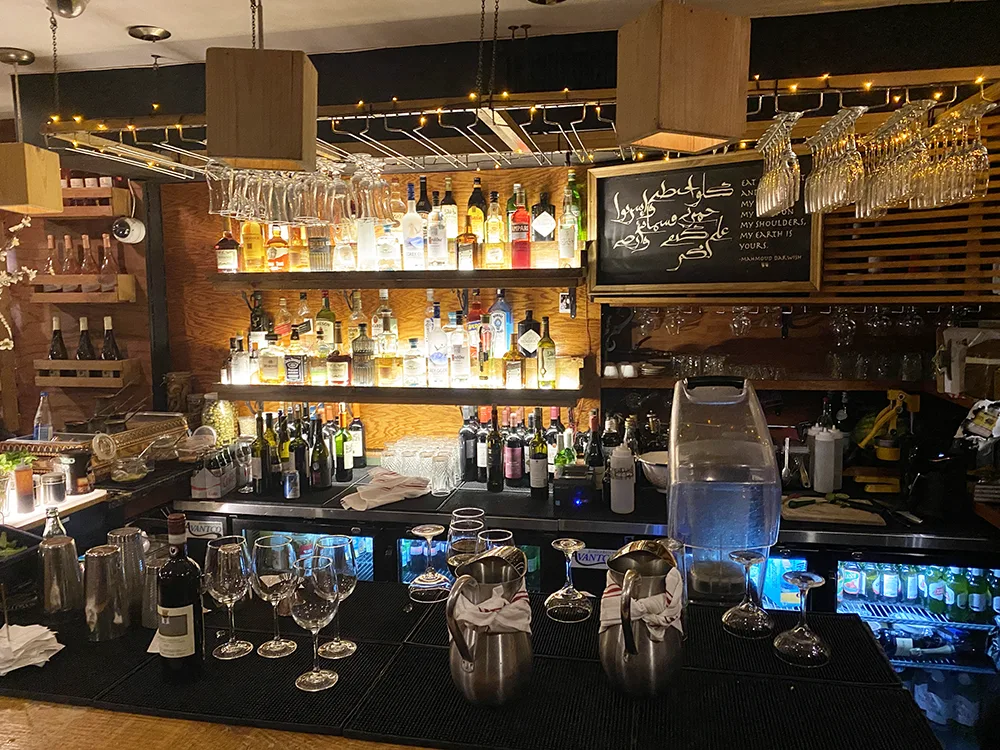
We met up with my brother and sister-in-law for drinks. We hadn’t seen them in a few weeks, not since early July when we had stopped in Ceraldi in Wellfleet. The East Village was a great middle ground between upper Manhattan and Brooklyn, and we started off having happy hour drinks at Drop Off Service like some fin-tech 20-somethings. Despite the city’s new ban on outdoor dining, the bar had ignored any effort to remove the outdoor space and we enjoyed the cooler summer evening.
Over our third round of drinks we debated our dinner plans. We had first considered Carnitas Ramirez only to learn it wasn’t open midweek. Disappointed, we headed down Avenue A hoping kismet would guide us. We spotted Au Za’atar on the first corner we came to.
Chef Tarik Fallous and his mother Salwa Fallous opened the restaurant in 2014. Au Za’atar bills itself as a Lebanese restaurant, and it made Eater’s list of best Middle Eastern cuisine back in 2018 -– a few years before the present zeitgeisty infatuation with cuisine of the Levant. Fallous opened a second location in midtown in 2021, although the build out was delayed because of the pandemic’s backlog of permitting.
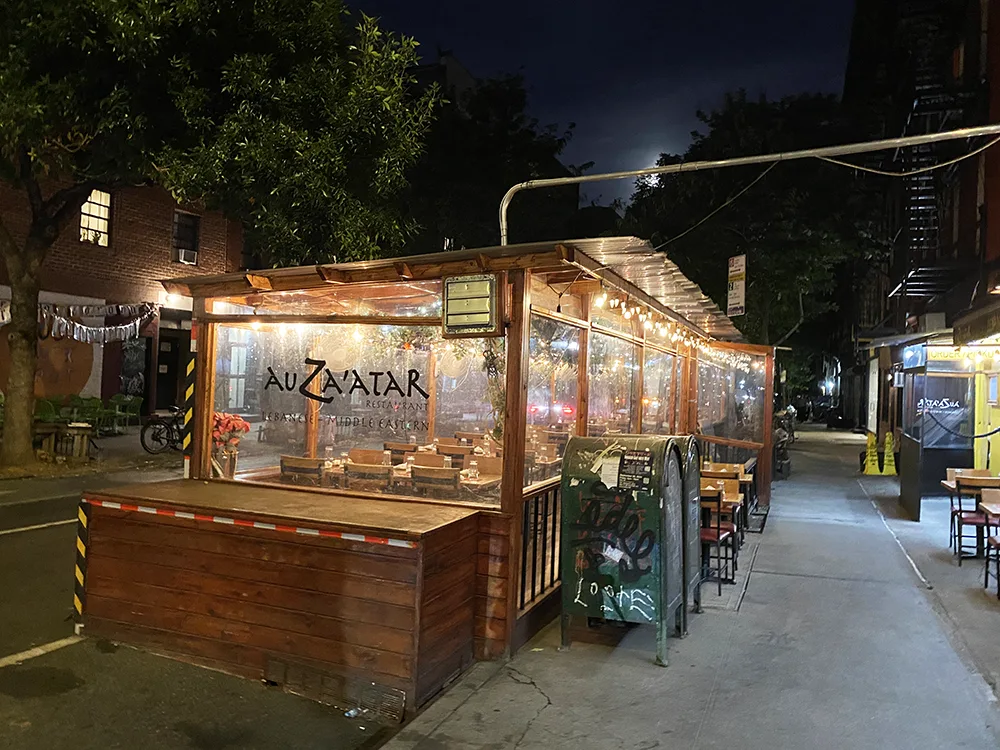
The East Village location of the restaurant still had outdoor dining sheds as well as cafe tables, but we ended up inside near the bar. Inside wasn’t all that busy, although more groups began filling in as it grew later.
We decided the best way of approaching the menu was sharing the mezze menu’s small plates. The first was a halloum mekli, a cheese that’s fried and served with a little bit of sweetness.
The Au Za’atar version of this dish arrived in a beautiful curled shape with a crispy exterior, and drizzled with honey. I have never had a bad fried cheese, but this version was truly a highlight of the night.
Alongside the cheese was little pile of olives and cucumbers masquerading as a salad. The freshness of the vegetables offset the sweetness and the heaviness of the fried cheese.

The Muhamarra, a dip made from walnuts, pomegranate molasses, and red bell peppers was also an excellent dish. The consistency of the dip was especially fine.
Muhamarra has become a go-to for me, so I’ve eaten a lot of it. This was one of the best in part because of the texture. I’ve had chunkier versions that are good enough, but the smoothness offered a nice mouth feel. I also think there was a bit more fat added to this one helping it feel silkier.
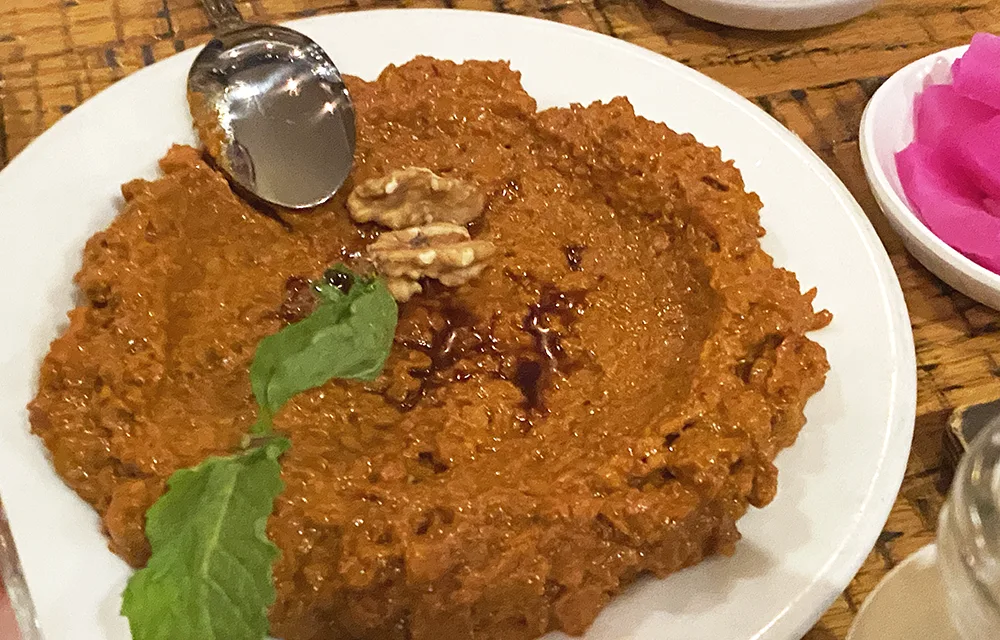
One thing we were short on though was pita. The waitress brought just one basket for four of us, and we had a lot of dips waiting for dipping. Eventually more arrived, but there was temporarily a pita management crisis.
We had ordered the mezze spinner, a tower of 6 small plates, plus a small dish of pickles. Each plate was suspended on a structure to save table space. We actually did have a problem with space as the food came, which is one of those first world problems.
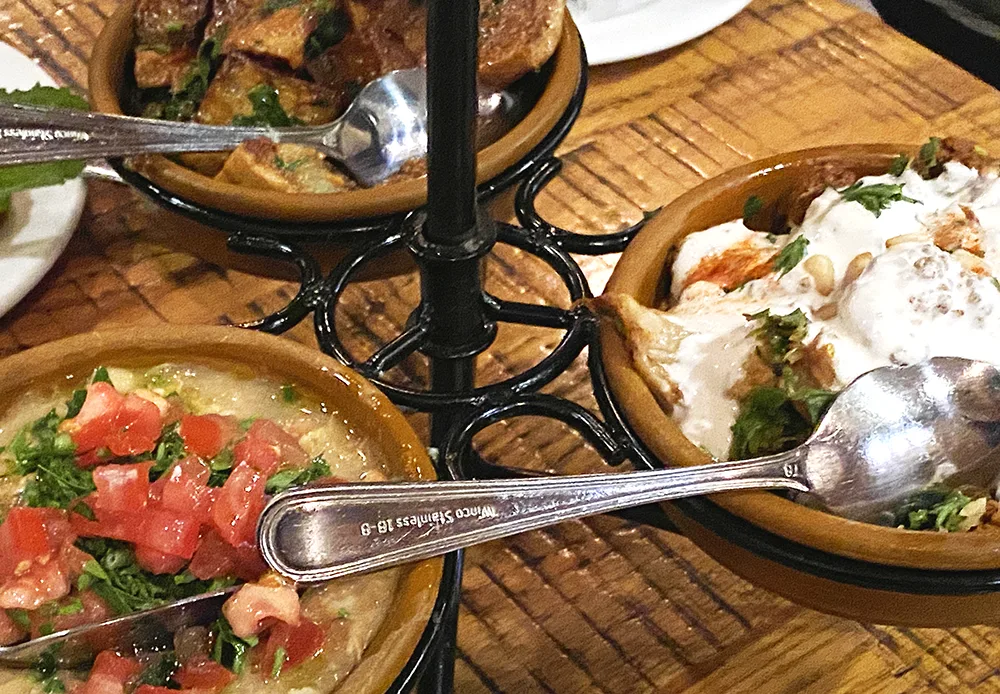
The spinner, as the name suggests, also spun around, making it easier for the four of us to access each of the different dishes. I couldn’t help but be reminded of the mezze platter that kicks off meals at Laser Wolf. There were differences between the two of course, with Laser Wolf offering new interpretations on classics, while Au Za’tar didn’t appear to be testing the boundaries of traditional flavors.

The Aarnabeet Bi Tarator, a Lebanese cauliflower dish, had nice flavor but overall could have been a little crisper, or at least less flaccid. That isn’t say it was bad, but the texture was seemingly off.
One plate had the fired potatoes. These were perfectly nice especially with the orange-colored hot sauce delivered to the table in a little glass bottle. There was something reminiscent about a Spanish potatoes bravas with the sauce; without, it was just a starchy snack, soft in the middle and not quite crispy enough.
The baba ganoush was particularly good because it was not too smokey. I find sometimes the dip can get an overbearing smokiness, or in cooking our own on a gas grill, it doesn’t always bring out enough of that flavor. All this is to say it was a very enjoyable version.
The foul medames, fava beans topped with tomatoes, was a bit disappointing. The acidity of the fresh tomatoes helped carry it, but overall I had hoped for a more vibrant flavor. Fava beans have so much potential, and here they simply were not memorable.
The hummus on the spinner platter hit the mark with a silky smooth consistency and a nice flavor. I suspect this recipe includes removing the chickpea skins, which is the only way hummus should be made.
We really started cooking when the Hummus bi Lahmeh arrived. The cool, silky smooth hummus was stopped with a pile of succulent chunks of lamb. The roasted pine nuts offered a bit of nuttiness.

I had high expectations for the Kibbeh Krass based on the description of “hand rolled shells made of a mixture of beef and bulgur wheat filled with ground beef.” The shell was paper thin and delicate, and enjoyed the flavor of the filling. However, overall the the dish came off as dry in the mouth – probably needed a little more fat in the filling.

On the other hand, the sambouisk lahme, little pockets filled with ground beef, were absolutely phenomenal with a good herb flavor and a slightly sweet crust.
They reminded me a bit of empanadas in shape and consistency. The pastry itself could have been a bit thinner, but also they clearly were handmade.
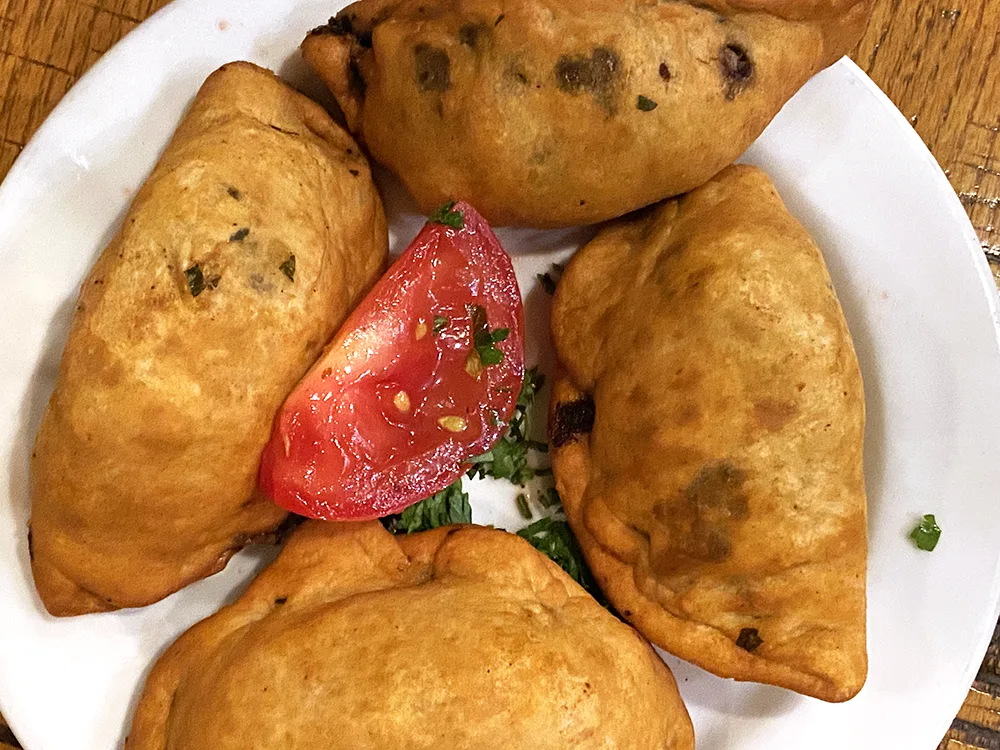
The same criticism stands for the Rekakat Lahmeh. I expected the phyllo to be thinner, like a paper shell. But it felt a bit gummy in the mouth, and definitely the ratio of pastry to filling could have been better. The filling itself tasted great, but I wish there had been more.
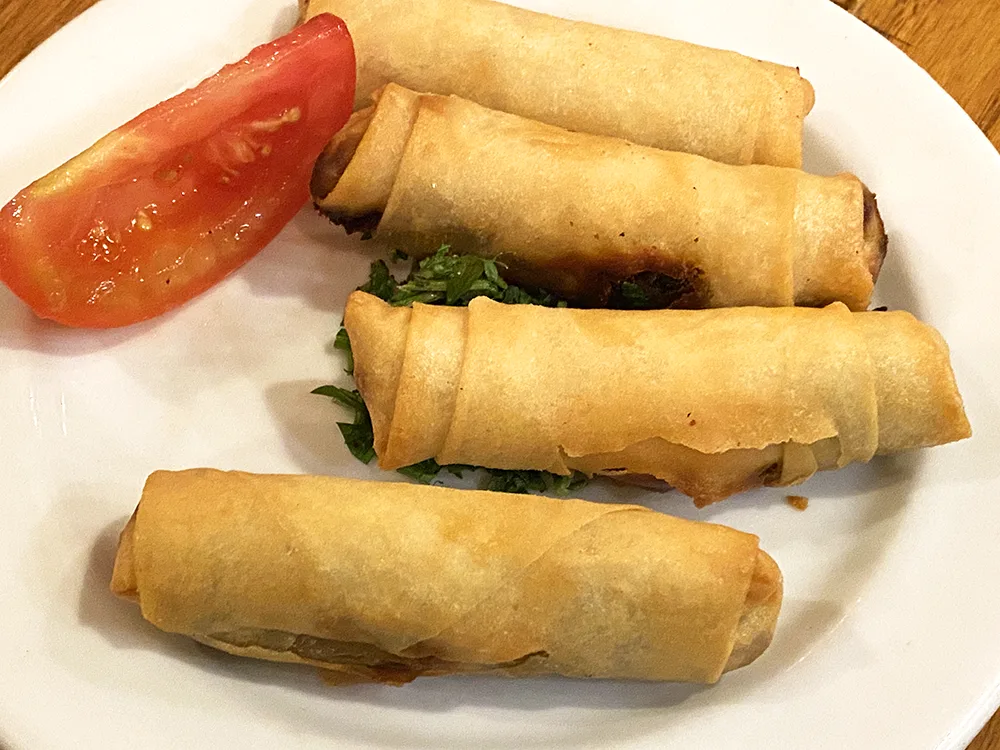
And it’s worth pointing out that despite ordering three similar pastries with meat and pine nuts, and each dish arriving with a slice of tomato, the experience of eating each one was very different and unique. As for the tomato, I don’t remember eating any of the slices, but I also think someone at the table did.
We sat for a few minutes after dinner contemplating dessert. We scanned the menu and joked about the birthday packages that included a bottle of prosecco or champagne and a sparkler candle. I ordered a Lebanese coffee, and left the dessert to everyone else.
While we waited, another party had ordered the birthday package. The restaurant staff gathered, turned up the music, and lit an enormous sparkler. The fountain of sparks looked like a handheld firework, as if Katy Perry herself was spewing birthday cheer from her bosom.
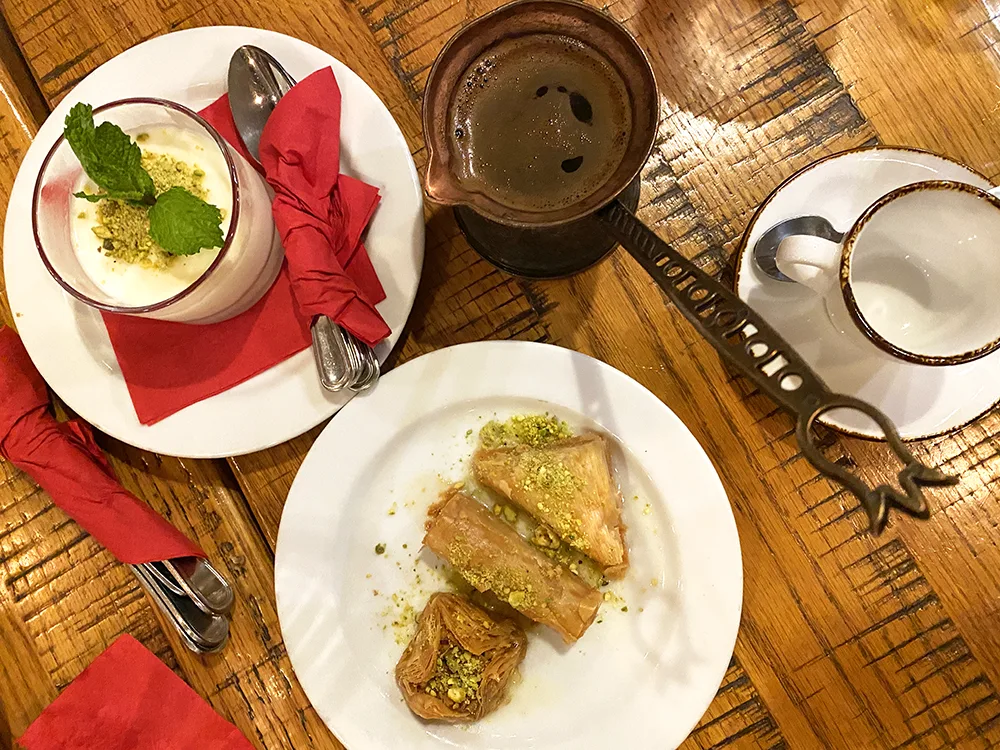
The desserts arrived with the coffee. The baklawa was better than I expected, but I always have low expectations for it. I believe the other little treat we had – again, I didn’t order it – was the Mouhallabie, a milky pudding topped with ground nuts. It was also satisfying.
As we were getting ready to leave, a waiter brought a nearby couple a tableside shawarma platter. The dish includes a rotisserie machine brought alongside the table. We’ll have to come back, I thought.

